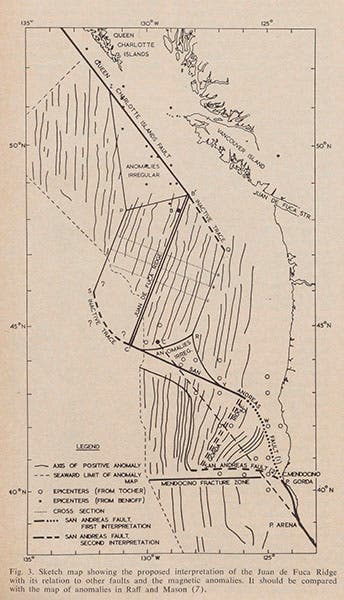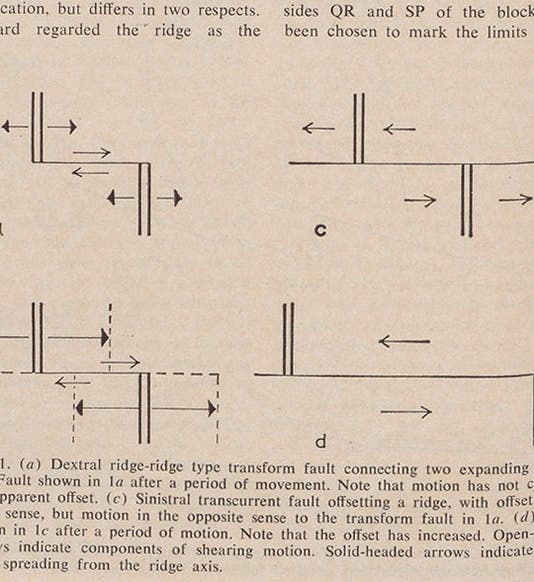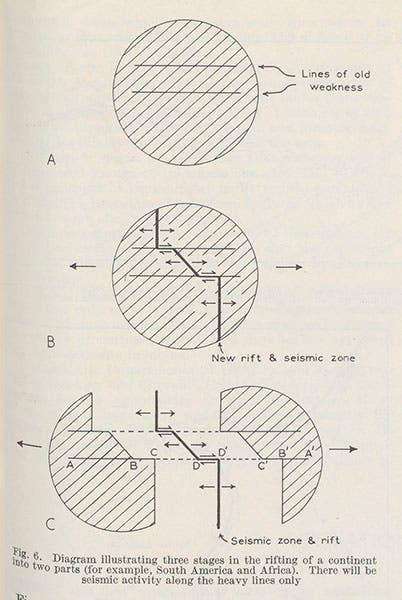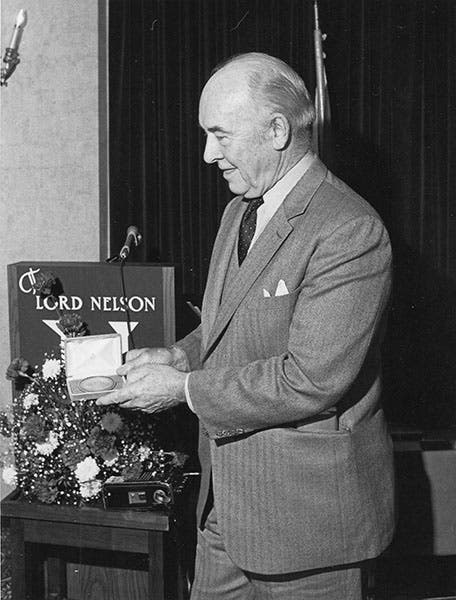Scientist of the Day - Tuzo Wilson
J. Tuzo Wilson, a Canadian geophysicist, was born in Ottawa, Canada, Oct. 24, 1908. His mother Henrietta, famous in her own right, was the the first to climb the 7tth peak in the Valley of Ten Peaks in the Canadian Rockies, a summit later named Tuzo Mountain. His father, fascinated with airplanes, was charged with developing civil aviation in Canada. Tuzo got his love of the outdoors and hiking from his mother, both requirements for extensive geological surveying. Influenced by his father, he was one of the first to use airplanes to conduct efficiently huge geological surveys – some of his contemporaries thought it was cheating. Graduating from the University of Toronto in 1930, he obtained a second undergraduate degree in geophysics at the University of Cambridge, where he took a class from the mathematical geophysicist Sir Harold Jeffreys, a leading opponent of continental drift. Leaving Cambridge, he secured his PhD in geology at Princeton University. He then took a position with the Geological Survey of Canada in 1926, and remained there for a decade before becoming a professor of geophysics in the physics department at the University of Toronto.
Throughout much of his career Wilson championed the gradual contraction of a cooling Earth as the working mechanism for mountain building, and he rejected the idea of continental drift as proposed by Alfred Wegener in 1915. Mapping much of the Canadian Shield and surrounding mountain belts, Wilson argued that the shield itself had existed since North America had formed, and that mountain belts had subsequently formed through the squeezing and upward movement of sediments that had collected in geosynclines along the periphery of the ancient shield. This process of mountain building continued, with ever younger mountain belts forming along the periphery of the growing continent. He argued that continental drift was not only unneeded to explain the geology of North America, but was unable to explain the stability of the Canadian Shield and the distribution of its surrounding mountains. A strict uniformitarian, Wilson also objected to the idea that continental drift had occurred only once, as Wegener had proposed. Wilson was not unfamiliar with the strong support for mobilism (drift) found in the Southern Hemisphere. On a trip to South Africa in 1950, he saw evidence in support of continental drift, but Wilson remained completely unconvinced. Wilson also rejected the paleomagnetic support for continental drift developed during the 1950s based on the divergence of apparent polar wander paths, and the fact that paleomagnetically determined ancient latitudes of the continents more or less agreed with those determined paleoclimatically by Wegener and Köppen.
Wilson’s views began to change in 1960, when he briefly adopted Earth expansion, and combined it with his geosynclinal account of mountain-building. A year later, he jettisoned Earth expansion for seafloor spreading. In 1960, Harry Hess had first proposed seafloor spreading, which required continental drift. Wilson began to take seafloor spreading seriously after reading Robert Dietz’s 1961 paper in which he presented his own version of seafloor spreading. Why did Wilson change his mind? Partly because he realized that he could not explain the origin of the worldwide system of mid-ocean ridges with fixed continents. He also realized that the paleomagnetic support for mobilism was correct.
Wilson then thought about what should be expected if seafloor spreading occurs. For instance, he reasoned that several Pacific island chains, the Hawaiian Islands being his best example, whose individual islands increase in age as their distance from the East Pacific Rise increases, could have formed by upwelling basalt arising from hypothesized fixed hot spots as seafloor moved over them. But his most important deduction from seafloor spreading was his hypothesis (1965) of a new class of faults, which he called transform faults. He also proposed an empirical test for their existence. He used the figure (first image) to introduce the idea of ridge-ridge transform faults, and how their existence can be tested. Mid-ocean ridges are made up of small segments offset from one another. They are represented as double vertical lines. The horizontal line in each figure represents the fault between ridge offsets. Arrows show the predicted movement with seafloor spreading (a and b) and without seafloor spreading (c and d). In addition, if seafloor spreading occurs, the seafloor moves in opposite directions along the fault only between ridge offsets; if seafloor spreading does not occur, opposing movements occur along the entire fault beyond ridge segments. Both differences were testable. In 1967, Lynn Sykes, a seismologist at the then Lamont Doherty Geological Observatory at Columbia University, found that earthquakes along faults occur only between ridge offsets, and that the direction of motion is what should be expected, if ridge-ridge transform faults exist.

Map of the Juan de Fuca ridge off the coast of Washington state, showing the ridge as a double line and the transform faults at an angle; the fault running southeast from the ridge, shown twice as a dashed or dotted line, is the San Andreas fault. From Wilson’s paper in Science, 1965 (Linda Hall Library)
Tuzo Wilson also claimed that Earth’s surface was made up of rigid plates, Indeed, he was close to proposing what became known as plate tectonics. However, he did not quite get there. Wilson did not apply his ideas to a spherical surface, and therefore, did not connect the idea of plate movements to Euler’s Point Theorem, which forms the mathematical basis of plate tectonics. According to Euler’s point theorem, the movement of a point (or ridge block) can be analyzed as the rotation of the point (rigid block) around a fixed pole, called an Euler pole. Perhaps Wilson was unfamiliar Euler’s theorem or failed to appreciate its importance. By own admission, mathematics was not one of his strengths.
Wilson’s proposal of transform faults was presented in two papers in 1965, one in Nature, one in Science. Our images come from both of those papers. The photograph shows Wilson receiving the A.G. Huntsman Award for excellence in the marine sciences in 1981.
Henry Frankel is Professor Emeritus of Philosophy at the University of Missouri-Kansas City, and author of The Continental Drift Controversy (Cambridge University Press, 2012).









